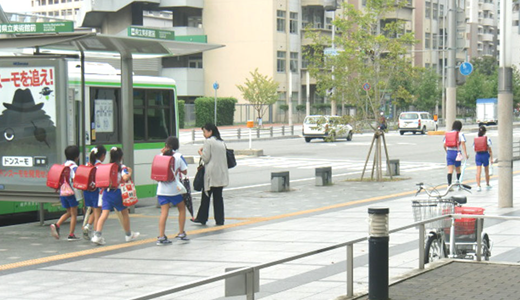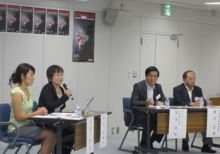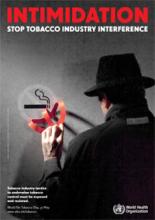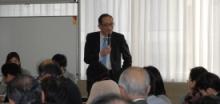2012

Parañaque City’s Urban HEART receives AFHC 2012 Award for Health Equity
The Tokyo-based Alliance for Healthy Cities (AFHC) organization awarded Parañaque City (Philippines) the 2012 AFHC Award for Creative Developments in a City Category on Health Equity on the merits of Parañaque City’s implementation of Urban HEART (Health Equity Assessment and Response Tool).
The award was presented during the 5th Alliance for Healthy Cities Summit held on 24 to 27 October 2012 in Brisbane, Australia.
Mayor Florencio Bernabe said “Urban HEART has been an invaluable tool in determining and doing away with the health service inequalities in the different communities in the city.” He explained that Urban HEART, in coordination with the city’s programmes on reproductive health and family planning, contributed to reducing maternal deaths and increasing child immunization in the city.

Walking to school in Japan and childhood obesity prevention: new lessons from an old policy
The Urban Health Governance (UHG) team of the WHO Kobe Centre has just published an article in the American Journal of Public Health, on Japan’s “walking to school practice” in relation to childhood obesity prevention. We suggest walking to school as an important element in reducing childhood obesity for lessons useful to other cities and countries.

Active travel to school, such as walking and cycling, has been identified as an important source of physical activity in children. Many developed countries, including some cities, are now promoting walking to school as a way to increase physical activity, aiming to tackle the epidemic of childhood obesity. Meanwhile, Japan has exceptionally high rates (98.3%) of active transport to school among children in public school compared with other similar-income countries. Japan has a highly established “walking to school practice” that has been implemented since 1953.
In Japan, each municipality has a board of education in charge of public schools, which considers the geography, climate, and the transport situation to determine the method of commuting. Because there is high availability of schools in urban areas and most are located within walking range of the children's homes, walking is the most common method. There are different safety initiatives depending on the district's characteristics. Parents, school staff, and local volunteers are involved in supervision.
The walk-to-school practice has helped combat childhood obesity by providing regular physical activity. Recommendations to cities promoting walking to school are (1) base interventions on the existing network of schools and adapt the provision to other local organizations, (2) establish safety measures, and (3) respond specifically to local characteristics. Besides the well-established safety interventions, the policy's success may also be associated with Japan's low crime rate.
to school are (1) base interventions on the existing network of schools and adapt the provision to other local organizations, (2) establish safety measures, and (3) respond specifically to local characteristics. Besides the well-established safety interventions, the policy's success may also be associated with Japan's low crime rate.

Related links
The American Journal of Public Health
"Walking to School in Japan and Childhood Obesity Prevention: New Lessons From an Old Policy"; Nagisa Mori, Francisco Armada, D. Craig Willcox.
American Journal of Public Health: November 2012, Vol. 102, No. 11: 2068–2073.

WKC course on “Health in All Policies and Noncommunicable Diseases (NCDs)” held at the 5th Alliance for Healthy Cities Global Conference in Brisbane, Australia
The Alliance for Healthy Cities Global Conference is held every second year. This year the conference was organized together with the 10 Day International Healthy Cities Forum from 22-31 October 2012, and it focused on “Healthy Urbanisation: Healthy People – Healthy Communities”.
During the conference, WKC held a 4-hour short course on “Health in All Policies and Noncommunicable Diseases” on 24 October.
The short-course provided the participants with information on HiAP and intersectoral action in cities, using NCD initiatives as an example. Recent research results and lessons learnt about effective interventions were shared.
Programme:
Presentations:
- Opening and background on WKC and UN work Health in All Policies (HiAP)/intersectoral action (ISA) and NCDs
- HiAP/ISA at local level
- Intersectoral responses to childhood obesity in New York, London and Cape Town
- 10 steps to implement HiAP/ISA

Mental Health Day

WKC networking event on “Empowering the Future of Cities” held at the 6th World Urban Forum in Naples, Italy
The World Urban Forum is organized by UN-HABITAT every second year and its 6th Forum took place this year in Naples, Italy, 1-7 September.
During the Forum, the WHO Kobe Centre held a networking event on “Empowering the Future of Cities: Addressing urban health and health equity through intersectoral action” on Monday, 3 September. This was one of the few events dedicated specifically to discussing health issues.
The event aimed to provide practical information on how to make cities more liveable and to assess and respond to urban health inequity through intersectoral action (sector collaboration and coordination).
Examples of intersectoral programmes were presented, and as practical guidance, the WHO “ten steps” for policy-makers to promote intersectoral action was shared.
Presentations:
- Mr Alex Ross, Director of WKC
Opening; WHO Ten Steps for Policy-makers to Implement Intersectoral Action on Health - Mr Jon Dawson, Jon Dawson Associates, United Kingdom
Intersectoral Action on Health in Urban Settings – Liverpool Active City 2005-2010 - Ms Maja Larsen, University of Southern Denmark
Challenges and Facilitators for Intersectoral Health Policy in a Danish Municipality

Assessing the impact of the ordinance banning smoking on selected streets in Kobe City, Hyogo, Japan
The WHO Kobe Centre is currently conducting a survey to assess impacts of the municipal street smoking ban ordinance in Kobe city in collaboration with the Department of Clinical Pharmacy of Kobe Pharmaceutical University. Professor Yamato from University of Occupational and Environmental Health Japan and the students from Kwansei Gakuin University "Cross-Cultural College – Canada-Japan Collaborative Program" have also been contributing to the project. Most of the ordinances on street smoking in Japan were implemented for environmental purposes; however, it is reasonable to expect that, properly implemented they could have health impacts, such as reducing exposure to second-hand smoke (SHS) on streets and facilitating smoking cessation among smokers.
Expected outcome of the survey include prevalence of smokers among pedestrians, number of smokers and cigarette butts, observed smoking behaviours, characteristics of the no-street-smoking zones, self-reported exposure to SHS, self-reported change in smoking behaviour, perception on smoking and tobacco control regulations and level of outdoor exposure to SHS on selected streets. As a result of analysis, the evidence gained through this research should help to further promote smoke-free environments and disseminate their benefits in cities with similar outdoor smoking restrictions.
A group of volunteer students from the Kobe Pharmaceutical University have taken the responsibility to carry most of the measures in the selected areas of Kobe city. They have participated with enthusiasm in the project, while having to face the challenging of the summer; they have shown great determination to make a contribution to the well-being of their fellow citizenships in Kobe.


Impact assessment: bringing sectors together to act on health
The UN General Assembly adopted the Political Declaration on Noncommunicable Diseases (NCDs) in 2011 and pledged to promote action through multisectoral action for health (MSA). However, MSA is a process that rarely occurs naturally and tools are needed to help facilitate and sustain the process.
On 20-22 June 2012, international experts, policy-makers and academics gathered at the WHO Centre for Health Development in Kobe to examine tools that will assist policy-makers to promote and sustain MSA.
Impact assessment has the potential to empower the health sector to develop an effective and mutually beneficial relationship with other sectors to coordinate action for health.

World No Tobacco Day 2012 - "Stop tobacco industry interference"
More than 60 participants came from academia, local governments and civil society groups to exchange their views and share ideas on tobacco industry interference on tobacco control policy in Japan.
The two-hour forum highlighted tobacco industry tactics to undermine tobacco control efforts, especially enforcement of smoke-free environments since Kanagawa and, this year, Hyogo adopted prefectural legislation to prevent public exposure to second-hand smoke.
Since the adoption of the WHO Framework Convention on Tobacco Control (FCTC) in 2004, Japan has struggled between the existing tobacco business related laws for the tobacco market and tobacco control plans to protect public health. Dr Yumiko Mochizuki, Division Chief of Tobacco Policy Research at the National Cancer Centre pointed out lack of Japan’s efforts in implementing measures on effective tobacco control policy based on the WHO FCTC and its guidelines and alerted that this has resulted in endangering public health and that public awareness should be raised for tobacco control policy to save lives.
Ms Mina Kashiwabara, Consultant at WHO Kobe Centre, presented on the Japanese tobacco industry’s intensive promotion of smoking manners and its impact on tobacco control policy. She emphasized that the industry’s smoking manners strategies have been used to avert the public attention from health impacts of smoking and to develop partnership with local governments to weaken tobacco control policy.
Kanagawa, the first prefecture to implement a local ordinance to regulate smoking in indoor public places in 2009, has also suffered from industry interference when developing the legislation. Mr Masatoshi Sekiguchi, a former member of the Kanagawa Prefecture Assembly shared a real life story of a tobacco company’s manipulation of public opinion – the tobacco company urged its employees to join Kanagawa’s opinion poll carried out in the beginning of the legislation to vote against regulating indoor public smoking.
Following the presentations, a vibrant discussion led by Dr Kohei Adachi, Vice President of Hyogo Prefecture Medical Association took place. Key issues, especially those encountered by the two prefectures, as well as broader trends in Japan of tobacco industry marketing and tactics hindering the implementation of tobacco control policy were discussed.
The forum ended with the closing remarks delivered by Mr Alex Ross, Director of WHO Kobe Centre. He emphasized the importance of full compliance to the WHO FCTC to protect public, and the commitment of WHO to promote health through stronger tobacco control measures.

World No Tobacco Day 2012
31st of May is World No Tobacco Day.
Each year, WHO and its member states celebrate World No Tobacco Day, highlighting the health risks associated with tobacco use and advocating for effective policies to reduce consumption.
World No Tobacco Day also promotes adherence to the WHO Framework Convention on Tobacco Control, an international treaty presenting obligations for all countries ratifying it. The theme for 2012 is “tobacco industry interference.”
In commemoration of this year's World No Tobacco Day, the WHO Centre for Health Development (WHO Kobe Centre) will organize an open forum in Kobe.
Date & venue:
31 May 2012 (Thursday) 15:00 –17:00
WHO Kobe Centre
Programme:
(language: Japanese)
15:00–15:10 Opening remarks
15:10–15:30 Tobacco control in Japan
15:30–15:50 Japan Tobacco’s manners campaign and local smoke-free policy
15:50–16:10 Kanagawa’s smoke-free legislation
16:10–16:50 Discussion
16:50–17:00 Closing remarks
Speakers:
(in order)
Dr Francisco Armada, WHO Kobe Centre
Dr Yumiko Mochizuki, Japan National Cancer Center
Ms Mina Kashiwabara, Consultant, WHO Kobe Centre
Mr Masatoshi Sekiguchi, former member of the Kanagawa Prefecture Assembly
Mr Alex Ross, WHO Kobe Centre
Moderator:
Dr Kohei Adachi, Hyogo Prefecture Medical Association

WKC Forum on Kaigo yobo interventions: the state of the art and future challenges in Japan
What are the future challenges facing the elderly? One of the many key questions posed during a forum attended by more than 60 participants at Hyogo Women’s Exchange Hall in Kobe City on 21 March, 2012.
Under the theme “Kaigo yobo: present and future challenges” the invited audience from many different spheres of interest, including universities, NGOs and local government, met to critically explore Japan’s current approaches on disability prevention. Kaigo yobo is a Japanese term that encompasses the notion of disability prevention among the elderly.
The two hour forum was opened by Mr Alex Ross, Director of the WHO Kobe Centre (WKC), followed by a brief introduction on the work of WKC by its Technical Officer on Urban Health Metrics, Dr Megumi Kano.
Keynote address - evaluating kaigo yobo:
Delivering the key note address was Dr Ichiro Kai of Tokyo University Graduate School of Medicine. He stressed the need to evaluate kaigo yobo programmes - including cost-benefit analysis - to demonstrate their effectiveness and value. However, he told the audience that the programmes should not be considered solely a health intervention, but also a “welfare” intervention. This therefore required subjective outcome indicators (e.g. quality of life etc.), though he admitted there were obvious challenges associated with conducting rigorous evaluations of this kind, especially in the community. He did close his speech on a note of optimism, with a call for the development of evidence-based kaigo yobo guidelines that are based on such procedures.
Research presentations: i) systematic review ii) evaluation methods:
Dr Kanako Masuno, a PhD researcher at Tokyo University, shared the findings from a systematic literature review on the effectiveness of disability prevention programmes both in Japan and overseas.
She said that there is plenty of evidence for the effectiveness of kaigo yobo in improving the physical health of the elderly, especially in fall prevention, but the effect of these programmes on other areas, such as on oral health, nutrition, cognition, mental health and social well-being is not yet well established.
Dr Yumi Kimura, a PhD researcher at Kyoto University, presented on recommended methods for evaluating kaigo yobo programmes and, specifically, on the utility of the healthy life expectancy indicator for monitoring and evaluating public health interventions.
A recent effort to standardize an evaluation method for kaigo yobo programmes nationally, was outlined, as were case examples of municipalities that showed the impacts of kaigo yobo programmes on health outcomes and healthcare costs.
On healthy life expectancy, an overview of the different calculation methods and the advantages and disadvantages of the indicator was shared, backed by examples of its use around the world. The potential for its use in Japan was also discussed.
Dr Kimura also presented findings from her field work on kaigo yobo programmes in Japan. She noted that despite the challenges, Japan’s programme is one of the most progressive in the world. She concluded with her vision of healthy ageing in the community with kaigo yobo, based on a multi-disciplinary, holistic approach.
Audience discussion:
The evening ended with the audience encouraged to share their experiences on kaigo yobo. Among the valid concerns was the gap between the needs of technical researchers and the needs of government officials who administer kaigo yobo. It was suggested this could be bridged by the two groups working more closely and by researchers addressing in their work the issues related to programme implementation.
Discussions also took place on evaluation methods – as highlighted during the key note address – as well as the need for greater awareness on gender sensitivities, for example, disease prevention among men, and musculoskeletal strengthening among women.

